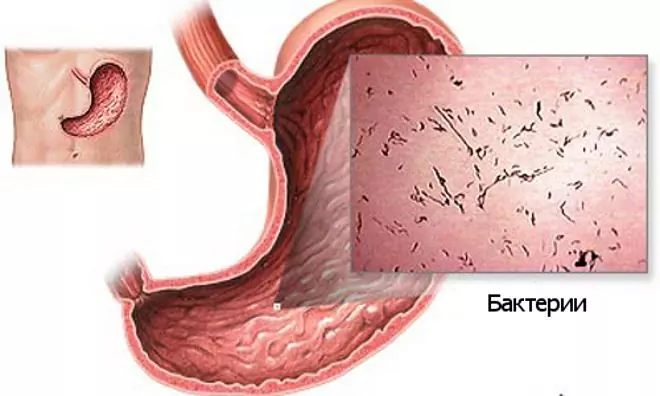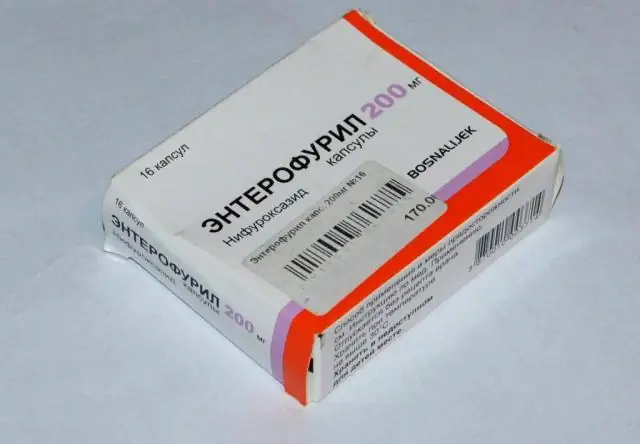- Author Rachel Wainwright [email protected].
- Public 2023-12-15 07:39.
- Last modified 2025-11-02 20:14.
Ampicillin
Ampicillin: instructions for use and reviews
- 1. Release form and composition
- 2. Pharmacological properties
- 3. Indications for use
- 4. Contraindications
- 5. Method of application and dosage
- 6. Side effects
- 7. Overdose
- 8. Special instructions
- 9. Application during pregnancy and lactation
- 10. Use in childhood
- 11. In case of impaired renal function
- 12. For violations of liver function
- 13. Drug interactions
- 14. Analogs
- 15. Terms and conditions of storage
- 16. Terms of dispensing from pharmacies
- 17. Reviews
- 18. Price in pharmacies
Latin name: Ampicillin
ATX code: J01CA01
Active ingredient: ampicillin (ampicillin)
Producer: Sanavita Gesundheitsmittel (Germany), BELUPO dd (Republic of Croatia), Sintez, JSC (Russia), Krasfarma (Russia), ABOLmed, LLC (Russia), Dalkhimfarm (Russia), Update PFC (Russia), Borisov plant of medical preparations (Republic of Belarus)
Description and photo update: 2019-16-08
Prices in pharmacies: from 26 rubles.
Buy

Ampicillin is an antibiotic that suppresses the synthesis of the cell wall of microorganisms, the activity of which is manifested against many gram-negative and gram-positive bacteria.
Release form and composition
Dosage forms: tablets, capsules, powder for suspension or solution for intravenous and intramuscular administration.
Tablets and capsules of the drug, 250 mg each, in a cell package of 10 or 20 pieces. The powder is sold in 60 g orange glass jars. It has a specific odor, white with a yellowish tinge, and has a sweetish taste.
The active ingredient in all dosage forms of the drug is ampicillin. The powder also contains vanillin, sugar, and other fillers.
Pharmacological properties
Pharmacodynamics
Ampicillin is a broad-spectrum bactericidal antibiotic. The active substance irreversibly binds to bacterial transpeptidases, which are involved in the biosynthesis of peptidoglycans (components of the bacterial cell wall), which determines the antibacterial effect of the drug.
Ampicillin is active against gram-positive aerobic bacteria - Enterococcus spp. (including Enterococcus faecalis), Staphylococcus spp. (excluding strains producing penicillinases), Streptococcus pyogenes, Streptococcus pneumoniae (excluding strains producing penicillinases), Streptococcus spp. (gr. viridans), Bacillus anthracis, Listeria monocytogenes, Erysipelothrix rhusiopathiae, Corynebacterium diphtheriae, to gram-negative aerobic bacteria - Neisseria meningitidis, Neisseria gonorrhoeae, Bordetella spertussia, some strains., to some anaerobes - Peptococcus spp., Clostridium spp., Prevotella melaninogenica, Peptostreptococcus spp.
Ampicillin is destroyed by the action of penicillinases produced by microorganisms.
Inactive against the following penicillinase-producing strains: Streptococcus pneumoniae, Staphylococcus spp., Most strains of Enterobacter spp., Klebsiella spp. and Bacteroides spp. (including Bacteroides fragilis), as well as all Clostridium difficile and Pseudomonas aeruginosa strains.
Pharmacokinetics
When taken orally, absorption is fast, high. The maximum concentration for oral administration of ampicillin at a dose of 500 mg is from 3 to 4 ng / ml. Time to reach C max - 2 hours. Approximately 20% binds to plasma proteins. Bioavailability - 40%.
The maximum concentrations after intravenous administration of ampicillin at a dose of 1000 mg and 2000 mg are respectively 0.04-0.071 mg / ml and 0.109-0.15 mg / ml. With intramuscular injection of 1000 mg of a substance, the maximum concentration of ampicillin varies within the range of 0.008-0.037 mg / ml. About 28% binds to plasma proteins.
The active substance is evenly distributed in the tissues and organs of the body, in therapeutic concentrations it is found in peritoneal, pleural, synovial, amniotic fluids, cerebrospinal fluid, skin, subcutaneous tissue, intestinal mucosa, urine (high concentrations), gall bladder, bones, lungs, bile, tissues of female genital organs, saliva, paranasal sinuses, bronchial secretions, middle ear fluid (in case of inflammation). Almost does not penetrate the blood-brain barrier, however, in the case of inflammation of the meninges, permeability increases.
The half-life is about 60 minutes. Ampicillin is excreted unchanged by the kidneys and partly through the intestines, and in breastfeeding women - in breast milk. During the first 8 hours, 75-85% of the active substance is excreted by the kidneys, and very high concentrations of unchanged ampicillin are diagnosed in the urine. Does not cumulate with repeated administrations. It is removed by hemodialysis.
Indications for use
Diseases caused by mixed infections:
- Pneumonia;
- Bronchopneumonia;
- Lung abscesses;
- Angina;
- Peritonitis;
- Cholecystitis;
- Sepsis;
- Gonorrhea;
- Intestinal infections;
- Postoperative soft tissue infections;
- Urinary tract infections caused by E. coli, enterococcus, proteus;
- Other infections caused by microorganisms sensitive to ampicillin.
Contraindications
According to the instructions, Ampicillin is not prescribed for hypersensitivity to the active substance, infectious mononucleosis and liver dysfunction.
Instructions for the use of Ampicillin: method and dosage
The drug is recommended to be prescribed after determining the sensitivity of the microflora.
Ampicillin tablets are taken orally, regardless of food intake.
When taken orally for adults, a single dose is 250-500 mg, the frequency of administration is 4 times / day. Children weighing up to 20 kg - 12.5-25 mg / kg every 6 hours.
For intramuscular, intravenous administration, a single dose for adults is 250-500 mg every 4-6 hours. For children, a single dose is 25-50 mg / kg.
The maximum daily dose for adults when taken orally is 4 g, with intramuscular and intravenous administration - 14 g.
The duration of drug treatment depends on the effectiveness of therapy and the severity of the disease.
Side effects
Possible negative reactions of the body: urticaria, skin rash, anaphylactic shock, angioedema, conjunctivitis, rhinitis, fever, exfoliative dermatitis, arthralgia, stomatitis, dysbacteriosis, gastritis, abdominal pain, diarrhea, nausea, vomiting, tremors, tremors, nausea, vomiting.
Overdose
Symptoms: signs of toxic effects on the central nervous system (especially in patients with renal failure), diarrhea, nausea, vomiting, imbalance in water and electrolyte balance (due to diarrhea and vomiting).
Treatment: gastric lavage is indicated, activated charcoal is prescribed, drugs to maintain normal water and electrolyte balance, saline laxatives, symptomatic therapy. It is excreted by hemodialysis.
special instructions
During the period of application of Ampicillin, regular monitoring of the peripheral blood picture, liver and kidney function is necessary.
When using higher doses of the drug in patients with renal failure, toxic effects on the central nervous system may be observed.
In the treatment of sepsis, in some cases, bacteriolysis reactions may develop.
Application during pregnancy and lactation
During pregnancy, the drug should be used with caution in cases where the potential benefit to the mother outweighs the expected risk to the fetus.
During lactation, the drug is contraindicated. If therapy is necessary, breastfeeding should be discontinued.
Pediatric use
Ampicillin tablets are contraindicated for children under the age of 4 years.
Care should be taken to prescribe a solution for intramuscular and intravenous administration of Ampicillin to children under the age of 1 month.
With impaired renal function
In case of renal failure (severe renal impairment), the drug should be used with caution.
For violations of liver function
In liver failure, the drug is contraindicated.
Drug interactions
In solution, ampicillin and aminoglycosides are pharmaceutically incompatible. If it is necessary to use it simultaneously, it is unacceptable to mix these drugs in one infusion medium or in one syringe. When administered intravenously, they should be administered separately in accordance with a certain sequence and the maximum possible time interval between infusions (injections) or using separate intravenous catheters. When administered intramuscularly, drugs should be injected into different parts of the body.
Absorption slows down and decreases with a joint intake of food, antacids, laxatives and glucosamine, increases - in combination with ascorbic acid.
With the simultaneous administration of ampicillin and bactericidal antibiotics (including cephalosporins, aminoglycosides, vancomycin, rifampicin, cycloserine), a synergistic effect is observed, ampicillin and bacteriostatic drugs (chloramphenicol, macrolides, tetracyclines, sulfonamides, lincosamides) - an antagonistic effect.
Strengthens the action of indirect anticoagulants (suppresses the intestinal microflora, lowers the synthesis of vitamin K, prothrombin index). Reduces the effect of taking estrogen-containing oral contraceptives (additional methods of contraception should be used), ethinylestradiol (the likelihood of breakthrough bleeding increases), drugs, as a result of the metabolism of which para-aminobenzoic acid is formed.
Allopurinol, diuretics, phenylbutazone, oxyphenbutazone, non-steroidal anti-inflammatory drugs, drugs that block tubular secretion, cause an increase in ampicillin concentration due to a decrease in tubular secretion.
Enhances the absorption of digoxin.
When ampicillin is used in combination with allopurinol, the likelihood of developing a skin rash increases.
Ampicillin increases toxicity and decreases methotrexate clearance.
Analogs
The analogue of Ampicillin is Ampicillin trihydrate.
Terms and conditions of storage
Store at a temperature not exceeding 25 ° C in a dry place out of the reach of children.
Shelf life is 2 years.
Terms of dispensing from pharmacies
Dispensed by prescription.
Reviews about Ampicillin
Reviews about Ampicillin for the most part include information on the use of the drug for sinusitis and angina. In severe cases of these diseases, injections of "pure" ampicillin or its combination with sulbactam are prescribed. Also, the agent is used in the treatment of pyelonephritis, cystitis, infectious diseases of the ear, throat, sinuses.
Patient reviews indicate that ampicillin rarely causes side effects - only a few patients report the appearance of nausea, vomiting, upset stools, rash and itching.
The price of Ampicillin in pharmacies
The approximate price for Ampicillin is 20 rubles. for 10 tablets 250 mg.
Ampicillin: prices in online pharmacies
|
Drug name Price Pharmacy |
|
Ampicillin 250 mg tablets 20 pcs. RUB 26 Buy |
|
Ampicillin 250 mg tablets 20 pcs. RUB 26 Buy |

Maria Kulkes Medical journalist About the author
Education: First Moscow State Medical University named after I. M. Sechenov, specialty "General Medicine".
Information about the drug is generalized, provided for informational purposes only and does not replace the official instructions. Self-medication is hazardous to health!






